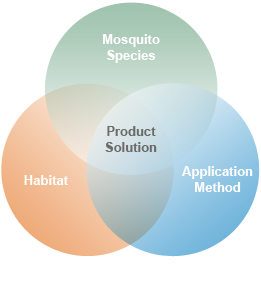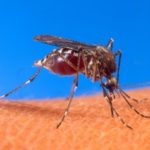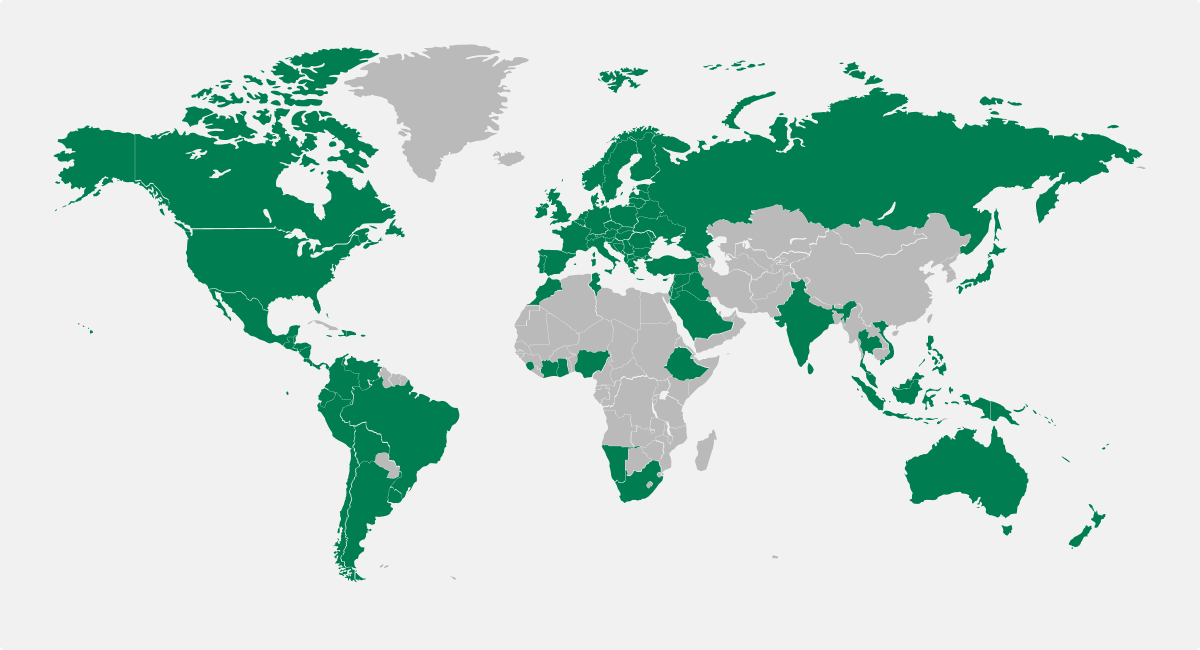The Value of Target-Specific
Biorational Larvicides in an Integrated Control Program

The challenge of controlling mosquitoes is a continuous problem. It exists not only in developing regions and
rural areas, but also wherever urban development converges with prime mosquito-larval habitats such as wetlands and irrigated agricultural areas.
Whenever possible, an integrated approach is the most effective strategy for mosquito control. An integrated program employs tactics that fall into three categories:
Whether the objective is nuisance or disease-vector control, each of these treatment strategies plays a key role in controlling mosquitoes.
Source Reduction
Source reduction can be called the most permanent form of mosquito control because it eliminates or reduces habitats where mosquitoes breed. Since many mosquito species lay their eggs in standing water, source reduction often includes the removal of debris or other vessels in which water collects — items such as buckets or discarded tires.
For this strategy, “reduction” is the operative word since it is often impossible to eliminate all sources of standing water in an affected area.
Larviciding
After source reduction, larviciding is widely considered the most effective form of mosquito control. Applied
using ground or aerial treatments, larvicides kill mosquito larvae before they become adults and become airborne. As larvicidal technology becomes better understood, larviciding programs are gaining widespread acceptance because they efficiently suppress mosquito populations in their most vulnerable stages of development.
Biorational larvicides provide a practical approach to controlling mosquitoes. When compared to the adult stage, mosquito larvae are:
Concentrated: clustered together in small areas
Immobile: not flying around from place to place
Accessible for control: not resting away from treatment areas
Adulticiding
Adult mosquitoes are ultimately responsible for disease transmission. Therefore, any program actively combating vector-borne disease will include an important adulticiding component. While not as efficient as other forms of control, adulticides serve as a necessary last line of defense. Adulticides are usually applied through ground and aerial applications, and are also used to treat bed nets that surround and protect the potential hosts.
The Right Product in the Right Habitat for the Right Mosquito
Decision-Making Factors
Effective, efficient control of mosquitoes depends on the interaction of key variables that dictate an often narrow range of potential control solutions:- Mosquito species: introduces biological and behavioral elements to the solution equation
- Habitat: the environment in which the target insect is found is critical in determining the most effective control
- Application method: dictated by the requirements of the target species and the habitat being treated, as well as application timing
Only by taking all of these variables into account can the best solution be identified.

Mosquito Species
| Genus | Public Health Concerns | Characteristics |
Aedes  | Floodwater Aedes: Severe nuisance; allergic reaction; economic loss; dog heartworm | Floodwater Aedes: Eggs are laid on damp or dry soil in floodplains and can survive extended periods of drying. Eggs hatch when flooding occurs, and large broods of mosquitoes can develop rapidly, resulting in severe infestations of aggressive biting mosquitoes. |
| Container Aedes: Dengue, Yellow Fever, Chikungunya | Container Aedes: Active during the day. Lays eggs just above the waterline, which then hatch after flooding. Eggs can survive in a dry state for extended periods of time. Adults will harborage in vegetation at night, which can render evening fogging tactics ineffective. | |
Anopheles  Source: CDC | Malaria | Found in tropical and temperate zones. The primary vector of malaria in tropical regions. In general, female prefers to feed on humans and is most active just before dawn and just after sunset. After feeding, lays individual eggs with floats on the surface of water or on wet soil at the water’s edge. In tropical regions, eggs hatch in 2-3 days. |
Culex
| West Nile Virus, Rift Valley Fever, Filariasis, Encephalitis Viruses (e.g., WNV) | The most widely distributed genus of mosquito in the world. Feeds on birds and mammals. Lays egg rafts directly on the surface of fresh or stagnant water. Prefers polluted water habitats. |
Habitat
| Typical Mosquito Habitats | Places Where Mosquitoes Like to Breed | |||
| Open Habitats | Vegetated Habitats | Permanent Water Sites | Floodwater Sites | Artificial Containers |
 |  |  |  |  |
| Open habitats refer to sparsely vegetated and spacious areas such as natural water bodies, floodplains, wetlands, etc. | Vegetated, or closed, habitats are also referred to as vegetated habitats, and include such areas as marshes, wooded swamps, and floodplains. | Swamps, ponds, sewage ponds, lagoons, ditches. | Sites that are flooded for brief periods throughout the year. . | Potable water containers, buckets, discarded tires, and other refuse. |
Application Method
| Area Size | Open or Vegetated Habitats | Open Habitats |
Small Area Backpack sprayers and hand treatments are recommended. | Granular power backpack, manual disk spreaders. Formulations: Granules (G, GR, GS, CG) | Liquid hand pump backpack or compressed air sprayer. Formulations: Aqueous, tablets (12AS [or SC], WG [or WDG], DT |
Medium Area Vehicle-mounted treatments (usually ATVs) are common. | Granular rotary seeder or vehicle-mounted power backpack. Formulations: Granules (G, GR, GS, CG) | Liquid power sprayers. Formulations: Aqueous (12AS [or SC], WG [or WDG]) |
Large Area Aerial treatments (typically GPS controlled). | Granular aerial applications: Sytems include rotor wing fix mounted, rotor wing sling bucket, and fixed wing fix mounted. Formulations: Granules (G, GR, GS, CG) | Liquid spray systems, usually large drop spray. Rotor wing or fixed — flat fan or raindrop nozzle system configured to minimize small drops. Occasional use of rotary atomizers for rice fields, etc. Formulations: Aqueous (12AS [or SC], WG [or WDG]) |
* VBC larvicides are available in a variety of formulations that match the specific needs of each application. This table provides guidelines for typical applications, although application methods can vary.
Product Solution
VBC Larvicides
VBC has the broadest portfolio of target-specific biorational larvicides for mosquito control that have become an integral part of many integrated mosquito control programs around the world. Four of these products are based on the microbial larvicides Bacillus thuringiensis subsp. israelensis (Bti, strains AM65-52 [VectoBac] and SA3A [Teknar]) and Bacillus sphaericus (Bs 2362, strain ABTS-1743). In 2012, VBC is poised to launch MetaLarv, featuring an advanced formulation of its new active ingredient (S)-methoprene. Appropriate in a variety of formulations for the appropriate habitat and application method, VBC’s range of biorational products kill between 95% and 100% of mosquito larvae when applied at recommended rates, depending on the species.
| VectoBac® and Teknar® | VectoLex® | VectoMax® | MetaLarv™ |
 |  |  |  |
| Active Ingredient: Bti. Recommended as quick control for a broad spectrum of mosquito species. Has shorter residual control. | Active Ingredient: Bs. More narrow spectrum (ideal for Culex species) with longer residual action. Performs well in both fresh and polluted water habitats. | Active Ingredients: Bti and Bs. Combines the strengths of both VectoBac and VectoLex. Quick and long-lasting control for a broad spectrum of species. | Active Ingredient: (S)-methoprene. Triple Release Technology™ allows for pre-flood applications to floodwater habitats. |


